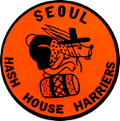"Half a Mind" on Freedom's Frontier,
still crazy after all these beers since 1972.
Korea's Mother Hash
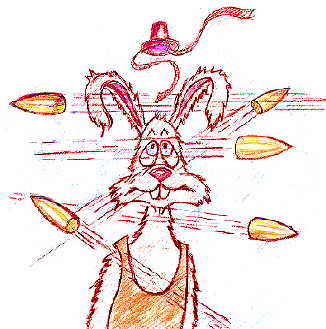
From the 1938 charter of the Kuala Lumpur Hash House Harriers:
- To promote physical fitness among our members
- To get rid of weekend hangovers
- To acquire a good thirst and to satisfy it in beer
- To persuade the older members that they are not as old as they feel
Join us from about 7:30 PM or so, after the Run, at the Seoul Hash pub.
Seoul Hash House Harriers' Song
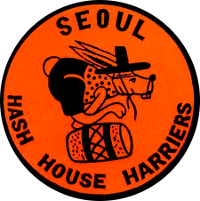
Way down south in Yeongdeungpo
That's the place I want to go!
Shiba-shiba haba yes!
Suck a chaji, maybe so.
Further north than old Pusan
Get your ass for a thousand won.
Catch the clap and you never go
On on to To-ki-yo!
In the war-torn town of Toko-ri
Mama-sans they make whoppee.
They smell of garlic and they're full of lice
But the pom-pom is very nice.
You pick up a girl on Korean street
You ask how much? She says you speak.
She takes you out, you're wined and dined,
You end up by going blind.
Korean huts are low and flat.
You squirm and crawl like a Chesire cat.
The mama-sans are much too fat
So you blow your stones on a bamboo mat.
Now that's the end of my tale of woe.
I'm off again to Yeongdeungpo!
Twenty-eight days I'll get no less
But shiba-shiba haba YES!!
Swing low, sweet chariot...
The Seoul Hash House Harriers, never claiming to be the Bob Dylans of the Far East, ripped this song with former GM Kimchi Marine's assistance from the US Marine Corps. Over time we have made a couple necessary changes, ending with the traditional Hash spiritual, Sweet Chariot, complete with gestures – some of which should never be detailed in public.
Yeongdeungpo is a community just south of Seoul. Shiba-shiba haba is bar pigeon English meaning "have shiba-shiba" ultimately translating into "getting laid." Chaji is the standard Korean slang for "dick." The thousand-won buy really dates the song; current prices are roughly 50,000 won on up. It takes no linguist to decipher pom-pom to mean "boom-boom" or "OnIn-OnOut-OnIn-OnOut." Finally, the twenty-eight days statement refers to the standard sentence in the brig for going AWOL (serving as a lift of the mug to our Hashers in uniform).
The Hash of Seoul
by Mike Seros
Arirang Magazine
Fall, 1979
The weekly run-cum-beer drinking ritual known as "Hashing" was a relatively obscure phenomenon outside the Malaysia-Singapore area until about ten years ago, at which time this peculiar form of madness began to sprout wildly throughout Asia and beyond. To date there are scattered worldwide about 120 branches of the Hash House Harriers, an "organization" which alleviates everyday pressures and commitment by means of some exercise, much companionship and a great deal of beer -all within the framework of institutionalized hysteria.
Most expatriates in Asia have by now read of how mature businessmen, pin-striped by day, will congregate in a different spot each week, take to the hills in a screaming frenzy and stagger back an hour later to attack iced cases of beer, the reward for traversing four to eight miles of wet rice paddies, thorn covered hills, incensed animals (and sometimes people) and whatever else nature may offer. Tropical settings contribute the ever oppressive heat; a run through a temperate climate's winterscape can result in icicles hanging from moustaches. For the Hash runs every week – rain or shine, wind or snow, war or peace. But running and then returning home is not Hashing.
Subsequent hours must be devoted to beer drinking and ancillary activities. Non-beer drinkers, although considered somewhat bizarre, are not discriminated against as post-run supplies include soft drinks and food. It's putting in the time that counts.
The legend of the founding of the original Hash is still in dispute. Recent excavations near the historical city of Malacca have led many to the conclusion that Hashing had . its genesis in the exploits of a fuzzy headed Greek-Australian by the name of Konomos, who used to run around the Malacca Padang to escape the mosquitoes. It is believed that some forty years ago in Kuala Lumpur, one A.S. Gispert, in attempting to duplicate Konomos' feats, somehow collected a following which Konomos for some reason could not, thus giving birth to the "Mother Hash."
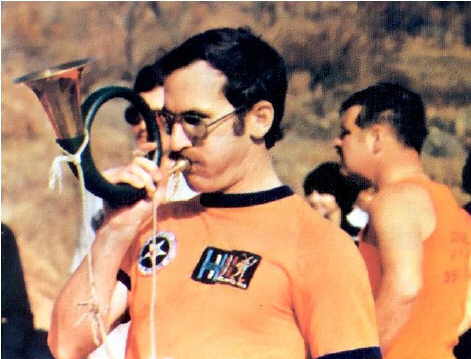 |
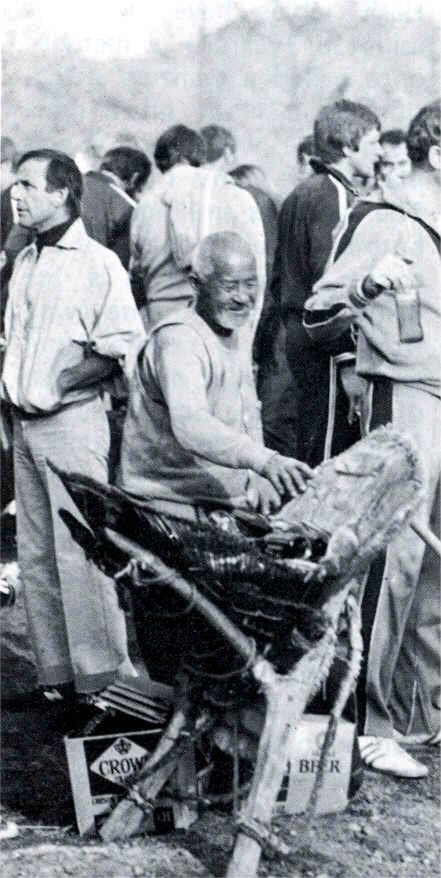 |
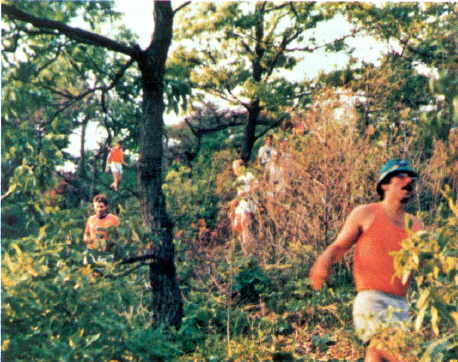 |
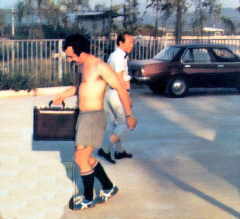 |
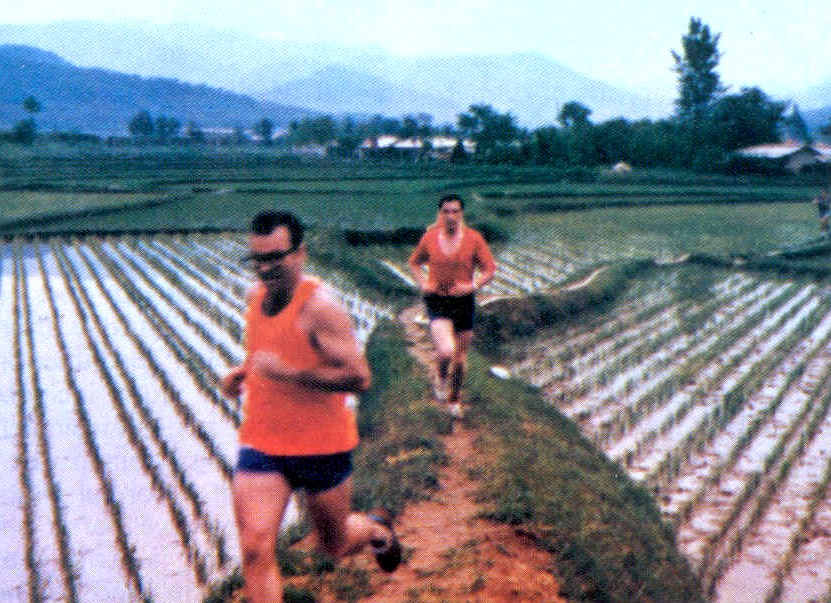 |
In Seoul, HHH has been alive and well since 1972 and the surrounding countryside hasn't been quite the same. The ROK army, in fact, has gradually come to ignore the Wednesday evening sight of fifty-some grown men clothed in orange singlets and foaming at the mouth while trampling the countryside underfoot. The Seoul Hash was founded under the motto of "Only Half A Mind" and continues brilliantly in upholding this tradition.
Since much has recently been written about HHH in general, perhaps a personalized and affectionate view of the Seoul Hash is in order. It has, like all Hashes, a distinctive character, a peculiar coloration and its own set of needs.
For most, the weekly cycle in Seoul begins late Monday afternoon when the first day of another seemingly insufferable week is edging to a close and the air is ripe with the smell of Hash Trash. The Trash is a largely scatological weekly publication. Both irrelevant and irreverent, it contains a ruthless commentary on the previous week's run plus bits of information relating to up-coming non-events, future Hares (person who sets and marks the trail) and directions to the site of the next run. This last entry is often as confusing as helpful and may lead the unwary on a convoluted chase in search of the orange HHH flag which dots the rural scene at a different point each week. The experienced Hasher, however, is nothing if not wary, and somehow the site is found by all, if not always on time.
On Wednesday, office hours end early in the attempt to reach the site by starting time. Often changing from suit and tie to running gear in the car, the Hasher is greeted by some 30 to 75 comrades-in-drinking, the number depending on the weather and other variables. There is a hard core which will be found at every run and feeble excuses, such as a wife giving birth, are not considered adequate. It is indicative of Hashing's growing popularity in Seoul that last winter saw no run of less than thirty people while veterans can recall some in the past attended by as few as six. There are a few madmen who not only never miss a winter run but also refrain from donning any "garment which would cover arms or legs. What price middle age glory.
At the On-On site, members of the waiting congregation pass the time in various states of repose, lugging on one last cigar or engaging in unnecessary stretching exercises. At the appointed moment, the Hare issues an unintelligible statement as to the marking of the trail, the Hash Horn (a noun given to the bugle as well as the person who carries and blows it throughout the run) sounds and, with cries of "On-On" reverberating, the pack sets off at every manner of pace. The run shifts and turns through every type of terrain available and each new check mark further spreads and divides the pack into small groups or individuals, each struggling to respond to increasingly distant "On-Ons" which signal new trails being picked up by the leaders. The original proud pack of a half-hour previous is eventually reduced to a disparate scene – some individuals running straight and hard, others stumbling and wheezing, enduring the laughter of villagers while trying to get home whole and without getting lost.
Hashing is by nature non-competitive and allows individuals to run the course as aggressively or walk it as softly as they like, but the technique known as SCB-ing (a uniquely Hash phrase describing one of questionable parentage who engages in shortcutting the trail) has reached high art form in Seoul. It can be discouraging to the less inventive runners who have steadfastly followed the trail only to see tail-enders continually reappearing in front of them. The Hare thus strives to lay a course which will make shortcutting difficult, but many veteran Seoulites are familiar with much of the country and this doesn't always work. Each Hare's proclivities also dictate the course, which can run the spectrum from pure mountain climbing to long, flat running.
An interesting phenomenon is that no matter how fast one runs or how single-mindedly one shortcuts, it is impossible to be the first back to the On-On site; there will always be someone already there, nonchalantly pulling on a beer. No one has yet been able to ascertain the source of this seemingly supernatural scene.
A recent run, typical in its confusion, saw a large group pick up, only five minutes into the run, the incoming rather than outgoing trail. Most of the pack followed suit and were shortly confronted with chalked arrows pointing in reverse of the running direction. Assuming "kids at work" (village children often change the trail around-or point out the wrong direction to passing runners) the pack pushed on. There followed a climb up a near vertical mountain, following trees marked with white paint. Finally the realization: this was the work of the Ministry of Agriculture, not the Hare. There ensued a scramble for home, every man for himself.
Back at the On-On, a festive air unfolds as the first-inners grab iced beer and an equally iced sandwich (gone are the traditional curries of Southeast Asian Hashes- Seoul is known for its "good guys" and accessible countryside, not for its food). A bonfire has been constructed and is surrounded by the growing gathering which mixes beer with discussions of politics, the prime rate, the just-completed run or whatever, while eyeing the stragglers filtering in, often blood spattered and cursing the ubiquitous SCB.
During the On-On, the Grand Master, whose position accrues from something less than a study in democracy, may hoist himself onto a rock to make vulgar pronouncements or to preside over a Mugging, a ceremony in which a departing Hasher is presented an engraved silver mug full of beer and duly doused with more of the same by his fellows. After an hour or so, many begin to leave and the fire gradually takes on an element of its own which nurses the flames well into the night's blackness and the moon's luminescence. Conversation now is subdued and this time is, for those who appreciate the fire, the most relaxed and rewarding of the Hash experience. It is a tired body, a bottle of beer, some heady conversation with good mates, and long sober stares into a flickering, mesmerizing flame. Only after the beer has expired is this part finished. The glowing coals are extinguished by means of recycled beer and the group heads through darkness to waiting cars, leaving a stench of smoke hanging in the air behind. The following morning will see the earth scraped clean of refuse and there will remain no sign of this particular evening's activities near this anonymous rice field. The Seoul Hash has moved on.
In the city there is another On-On unfolding – more raucous, less aesthetic, but equally necessary for some. Many Hashers have begun to regroup into a neon studded club in the gaudy district of Itaewon. There is a large bank of tables set apart on Wednesday evenings by their white tablecloths and clusters of soiled, straining men who are clearly not part of the disco crowd. The Hash tables have been set aside for years – a member once called a waitress' attention to a cloth on a non-Hash table, whereupon it was matter of factly ripped off . The wenches smilingly distribute beer, calling many of the group by name. This is, for many, a weekly home away from home, a respite from who knows what, and a source of resentment – some obviously feigned and some no doubt real – on the part of many Hash wives. Wives and girl friends are not allowed into this Wednesday evening sanctuary; one periodically hears stories, related with intense eyes and furrowed brows, of what happened to Hash members who brought their wives to Itaewon after a run. Some of the men dance with female customers to the music of a tinny band. Most remain seated, pulling apart bits of rubberized chicken, attempting conversation over the disastrous din. This Hash enclave in Itaewon shows a study in types – some enjoy this part, many need it, others appear bored, sitting stone-faced and clutching beer.
In recent years there have evolved a few ladies Hashes (Hong Kong and Singapore have large distaff clubs – no such animal yet in Seoul) known as the Hash House Harriets. Although the traditional Hasher will volunteer this concept is carrying democracy too far and Gispert is no doubt now revolving in his moist, tropical grave, the Seoul Hash makes a biannual concession to its loved ones in the form of a Saturday afternoon coed run. The function following the run includes better food, better music and better looking women than – found during a normal Hash, but these are wives, after all, and the event is held with little comment and some grumbling. The last Ladies' Run was held in a beautiful area near the South Mountain Fortress. The Grand Master presented the first lady finisher with a discarded Korean shoe wrapped in a dirty newspaper and the post-run fire collected a top quality group of local residents – several women roamed through the group peddling greens, and an old stubble-faced, toothless man who, with a bummed cigar, stub between his gums, filled his hod carrier to capacity with empty beer bottles and I somehow hoisted this booty onto his shoulders and away.
It is this latter group -the local resident, the unflappable Korean farmer – which comprises a kind of universal third nationality and allows the Hash so much of its license. Children, and adults alike, they may dot the course and fringe the fire, collecting empty bottles, hustling beer and cigarettes, and generally enlivening the Hash fire, whether it needs it or not. But they view the sight of a dozen plus nationalities running across their land with nothing more than laughter and bemusement and one is hard pressed to imagine the North American or European counterpart reacting to such proceedings with anything less than a shotgun.
With a full cross section of members and, years of history upon which to draw, HHH vignettes naturally abound. One of the more famous is of the Hashers in Malaya during the Emergency who followed the trail through a camp of startled guerillas and later reported the position to government forces. There are many others, especially in Asia where Hashes frequently run afoul of local security boundaries. And there are numerous tales of the missing Hasher who has lost his way and doesn't return home until the following day. There are, infrequently, anecdotes spiked with tragedy as well – the Taipei Hasher accidentally drowned a couple of years ago; the hanged woman discovered during a Hong Kong run.
Seoul has contributed to the lore. A visiting American journalist running with the Hash here last year was in the lead and inexplicably took a sharp turn only 200 meters from the finish. Ignoring the shouts of runners from behind, he vanished into the bush, to be found in darkness two hours later wandering along a village road. Questioned on this peculiar (even for the Hash) tactic, he replied, " I got excited." Another Seoul Hasher once arrived late for the run, took off after the pack and eventually became lost finally surfacing from dense hill country, with the evening's curtain rapidly falling, he found himself in the middle of the Korean Folk Village -and about three miles from the waiting beer. Calling on his years of military training, he re-entered the hills, made another loop and arrived, fifteen minutes later in total darkness. …at the Korean Folk Village. At this point he took a taxi (Hashers often carry an emergency fund) back to the fire and a volley of honking horns, flashing car lights and not-so-delicate insults. And finally, the Hasher who fell into a manure pit and almost drowned.
HHH maintains little in the way of organization, but each club keeps a record of the number of runs since inception and gala celebrations (more beer) are held to commemorate various multiples (K. L. recently had its 1717th run). In 1978, Hong Kong hosted an "InterHash," during which hordes of latent drunks from allover Asia and the rest of the world converged on the Colony to participate in a series of runs and drink fests. There were some subsequent charges of over-organization.
The Seoul HHH 350th run was held early this year through a soft and persistent snowfall. The run itself illustrated the beauty of Hashing in a temperate zone; the course was totally white, in perfect polarity to the usual greens, browns and yellows, and the running was gentle and quiet. A bath house session followed scores of steamy, hairy men with shampooed heads, protruding cigars and cans of beer, soaking in the central tub. A study in barbarianism, such a scene in Japan would call for a month's fumigation of the premises, but this is Korea, where all is taken in stride. Next, a visit to a nearby kisaeng house on the top of a snowy hill. In true Hash fashion, it was a third grade house. Inside, it was freezing, lending an eerie cast to the shirtless Hashers sprawled on the floor. Into the night with cases upon cases of beer, tables of food, an outrageous band, dozens of semi-horrified young ladies, a few smuggled bottles of tequila. What more could a man ask?
Thus, in today's world of sports in which professionalism has run amok and amateurism has been subjugated by jingoism, one can still find respite. The weekly cycle turns, and turns again; the narcotic is there to soothe cares and ease pressures. And the good times are etched in memory. The Grand Master and I are talking after a run. He reaches into his pocket and pulls out a singed and crumpled piece of orange fabric. "You know what this is?" he asks. " It's the Hash flag. It fell in the fire last week and was left behind. I went back the next day and got it." He holds it up and examines it with a slight grin.
Nearby, RTD (everyone has a Hash name) is holding forth at the fire. He is an Emeritus Master by virtue of having been on Seoul Hash Run Number One seven years ago and most of them since. At this moment, RTD, holding a beer, kicks at the embers and observes to no one in particular, "growing old gracefully, lads, that's what it's all about."
History of the Hash Disorganization
This article was largely based large on the essay written in 1992 by Mike Lyons, Kuala Lumpur HHH, from research material prepared by John Duncan; and transcribed in 1994 by Tom "Self-Executing Officer" Moore, On-Sec, Boston H3, and edited by Chas. "ZiPpY tC" Baumerich, On-Sec, Pikes Peak H4 for the The Hash Bible, "Chapter 1, From Humble Beginnings, A History of the Hash House Harriers."
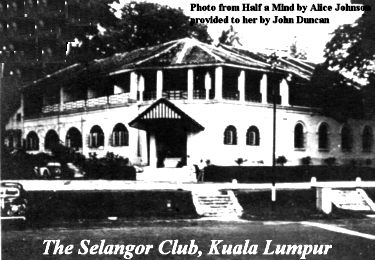
The Hash House
The "Hash House" was the mildly derogatory nickname given (for its unimaginative, monotonous food) to the Royal Selangor Club Chambers in Kuala Lumpur by the British civil servants and businessmen who lived and dined there between the two World Wars, when it had become something of a social center of the times.
Situated close to and behind the present Selangor Club, its function changed after independence and it became an office for the Water Board. Sadly, the "Hash House" was demolished around 1964 to make way for a new highway, Jalan Kuching, although the buildings housing the original stables and servants quarters are still in existence.
It is generally accepted that the sport of Hash House Harriers, in contrast to other hare and hounds groups, was defined by this particular club and all other groups of the Hash House Harriers can trace their lineage (directly or in concept) back to the Selangor Club Chambers or the Hash House in 1938.
The Ancient Harriers
The idea of harriers chasing paper was not new to Malaya in 1938, as there had been such clubs before in Kuala Lumpur and Johore Bahru, and there were clubs in existence in Malacca and Ipoh (the Kinta Harriers) at the time. Note: the early harrier groups in Malaya were based on English public school "paper chase" or "hare & hound" runs, which date back as far as the 18th Century (Flying Booger).
"Horse" Thomson (one of the Kuala Lumpur Hash House Harriers' founding fathers) recalled being invited on a run shortly after his arrival in Johore Bahru in 1932, which chased a paper trail and followed basic Hash rules every week, but was so magically organized that it had no name. The club flourished in the early 1930s but is believed to have died out around 1935. The other branch of our ancestry comes from Malacca, where A. S. ("G") Gispert was posted in 1937 and joined a club called the Springgit Harriers, who also operated weekly under Hash rules and are believed to have been formed in 1935. Some months later, "Torch" Bennett visited him and came as a guest on a few runs.
In any event, Hares and Hounds style chases have been around for centuries in one form or another. Of course the original concept was to mimic the original hunting sport during times or in locations where sporting game was sparse or children mimicking the hunt as practiced by adults. Some "gentlemen" substituted men for the game in an effort to add something different to the sport. There are stories of this in colonial America as well as in England.
It was a normal transition, then, to also substitute the hounds as well with runners. Men, not as well endowed with the sense of smell, required a trail of paper to their quarry. This sport was well entrenched long before these sportsmen became known as 'hashers'. The sport was referred to as Hares and Hounds or the Paper Chase.
It is pretty much a tossup whether children, immolating the hunts of the adults, or adults looking to make a new running sport, developed the sport of hares and hounds first. There is evidence chronicled in the nineteenth century of the hares and hounds being a popular sport amongst English boarding or public schools.
One such story was listed in the On On Run #2 published by Tim Magic Hughes of Harrier International. It was taken from Tom Brown's School Days by Thomas Hughes published in 1857. It depicted a meet by the Big-Side Hare and Hounds. Students busily tore up old newspapers, copybooks and magazines into small pieces to fill four large canvas bags with the paper scent. Forty or fifty boys gathered for the run and two good runners were chosen as hares who donned the bags and started across the fields laying trail. There would be a turnaround point at a church to discourage shortcutting, as the finish was known. The object, explained at the start, was to make the turnaround and finish at the pubwithin fifteen minutes of the hares. The hares were given a six-minute head start, then the pack was off. When scent was located, the member of the pack calls "Forward!" instead of the currently traditional "On On!", otherwise the description of the trail is a typical cross-country fare familiar to all harriers - meadow, hedgerow, fence crossings, plowed fields, thorns, brooks, shiggy and hills. Members of the pack worked together finding scent and straining to keep up with the FRB's (Front Running Bastards), as we call them today. The disappointment of the DFL's (Dead Fucking Last's), again a term of today, was depicted as they contemplate short-cutting to the finish and being among the first historical SCB's (Short Cutting Bastards).
Another such story related by Magic is the beginning of the Thames Hare and Hounds which held a "handicap paper hunt" on October 17, 1868. The following excerpt from the Illustrated London News on November 17, 1869 gives a good depiction of the harrier sport in that day. As it is today, although many hashers will refuse admit it, the Hares and Hounds clubs of that day relied on cross interest from several sporting clubs. The Thames Hare and Hounds apparently came from the membership of the Thames Rowing Club who had previously held steeplechases. Harrier clubs were prevalent in cross-country races as their members are in races today. Although the Hash House Harrier branch of Hares and Hounds shuns competition, it nevertheless draws much of its members from the running community, as well as other sports today.
To get a flavor of the hares and hounds of that day, read the following quote, also found by Magic, from Cassell's Book of Sports and Pastimes, published in 1883.
"This game is more generally known as 'Hare and Hounds', but the name of 'Paper Hunt' is equally descriptive of the game as it is really played. Clubs, calling themselves Harriers, are established in the neighbourhood of most large towns, and are recognised as athletic clubs, and as such permitted to enter for the sports of Athletic Club Meetings.
"Any member of players can form themselves into a team, and each time a run is decided upon, one of the players is selected to play the part of the Hare. It is not well, for the sake of the hounds, that the Hare should be the fleetest of foot, but should be selected mainly for his staying powers and for his knowledge of the surrounding country, in order that the pains and penalties visited upon trespassers may be avoided by Hare and hounds alike.
"'Law', being a certain number of minutes start (usually ten), is given the Hare, who provided with a large bag of cut paper (technically called 'scent') runs off, occasionally scattering scent as he proceeds. The hounds should be led by the quickest runner of the party, and he is generally known as the Master of the Harriers. The Whipper-in who brings up the rear, carries a small flag, and should be a lad of tact and management, able to cheer up the weak ones and control the refractory. The Master carries a horn, and runs on as well as he can from the scent, he announces the fact to the pack by blowing three blasts on the horn. The pack immediately halts, Whipper-in plants his flag at the last scent, and the hounds circle round the flag, each from his halting place. Scent is thus soon recovered, the Master is informed, and with another sound of the horn all are at once in file, the flag is again waved aloft by the man in the rear, and all proceed again with their "Yoicks" and their "Tally-hoes" resounding merrily. So on, for the whole run, the game continues until either the Hare is run to ground and caught, or until his pursuers, baffled and pumped out, exhausted, give up the chase for the day, allowing the Hare all the glories of being hunted again on the next outing.
"Some authorities give it that the hounds must make no short cuts, but are bound strictly to follow the scent; this is a law difficult to enforce, and is hardly fair to the pack, for although all help in finding a lost scent, yet otherwise, the pack, as a whole, is no stronger, in the matter of fleetness, than it weakest or slowest member.
"The game needs practice before it is wise to attempt very long runs; trained Harriers, however, after a season's work look upon a run of anything less than twenty miles as a rather poor affair. They, like the genuine Fox-hunter they hope some day to become, enjoy a right good burst across country, and then take the train home."
Several harriers groups sprang up in the later part of the nineteenth century. With the advent of other sports, hare and hounds did not have the popularity of its earlier years and later became more of a fringe sport, however it was kept alive, especially as it moved later to the colonies.
The earliest colonial running hunt experience was depicted in a recent movie, where in American colonial days men were used as quarry while the English chased them on horseback with hounds in pursuit. Of course this depiction is one of cruelty, but nevertheless indicates that there was an earlier time when men were substituted in the hunt.
According to Magic's research, there were hares and hounds groups in Malaysia as far back as 1927, when the Kuala Lumpur Harriers was founded. It is possible there were earlier hounds and hares events. This original K.L. group was a mixed club which went until at least 1932, when there was this piece in the Malay Mail:
"Thirty-six turned out on Sunday for the concluding run of the season of the Kuala Lumpur Harriers. Starting from Pudu Ulu railway station, Messrs. Simpson and M. B. Hutchinson laid a trail towards Pudu Hill with a series of cleverly thought out false scents.
"Rain, which came soon after the start, helped the hares considerably by washing away the trail. In the latter stages of the run, the pack was disorganised because of this, and the return from the slopes of Pudu Hill presented a series of problems in hunting the trail."
There is evidence of a harriers group at the Kinta Valley tinfield in Ipoh and of an earlier Selangor Harriers from the same gentlemen's club which later spawned the Hash House Harriers. Magic relates another group, "In Singapore, Royal Navy personnel based there with their families, regularly organised a very early form of 'hashing'. They used to engage in 'lunatic paper-chases' which used to astonish the local residents as they ended up in 'alcoholic binges' every week. Chittagong HHH (Bagladesh) Master's mother recalls with pain: 'I remember my mother dragging me around these paper-chases, much against my will, at the age of seven.' That was in 1929."
When you take this into account, you realize that the Malaysian harrier tradition that combined an equal amount of drinking and hare and hounds sport into one club indeed gained its foundation earlier than the reported founding of the Hash House Harriers. Remember, what separates the Hash House Harriers from other harriers groups is as much emphasis on the social camaraderie and non-competitive aspects of the group activities, as on the sport of hare and hounds itself. Thus, the earlier Malaysian harrier groups are indeed the direct ancestors to the sport we know as hashing today.
In evidence of this, Magic reports several early hash-style groups through interviews with one of the first Joint Masters of the Hash House Harriers, Frederick Horse Thompson. Horse relates joining a harriers group in Jahore Bahru which held runs from 1932 to 1935. Another was started in Malacca in 1933 or 1934, then he participated in a harriers group in Taiping. In 1934 or 1935, there was a Spinggit Harriers located at Pringgit Hill in Malacca. Reportedly, G, who later founded the Hash House Harriers, often ran with them.
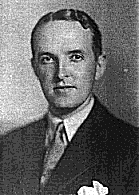
The Hash House Harriers
Born Alberto Stephano Ignatius Gispert in Greenwich, London, England, he was the youngest of seven children. His parents were Spanish and had immigrated to London prior to his birth, making him an Englishman. He went by the first two names and family name only, in accordance with the Anglican tradition, however his friends called him 'G'. When he became an accountant in 1928, he sought employment overseas and was sent to Singapore, then a state of what is now Malaysia. He signed a four-year contract with Evatt & Co. (later a member firm of Price Waterhouse). Former Senior partner Tom Aiken, in his booket Evatt & Co - The First 50 Years, states, "Gispert was one of a splendid bunch of follow-up young men. All seemed set for the future. Our practice was expanding and we were better placed than the other local professional firms to take advantage of the opportunities open to us."
In 1934, Gispert was sent to meet Ronald Torch Bennett (nicknamed for his red hair and who later became a founding member of the Hash House Harriers) when he arrived as a new member of the firm. They quickly became good friends. Torch was transferred to Kuala Lumpur in 1936 and Gispert was transfered as branch manager in Malacca in 1937.
In that year, which G was on U.K. home leave, his son Simon was born to his bride-to-be Eve. It seems that Eve was not quite divorced yet from her former husband, costing him a fine of 200 pounds sterling. Some hashers to date find this bit of tabloid quality behavior on his part appropriate for the irreverent nature of subsequent membership of the Hash House Harriers.
The idea of Harriers chasing paper was not new to Malaya in 1938, as there had been such clubs before in Kuala Lumpur and Johore Bahru, and there were clubs in existence in Malacca and Ipoh (the Kinta Harriers) at the time. "Horse" Thomson (one of the KLH3 founding fathers) recalled being invited on a run, shortly after his arrival in Johore Bahru in 1932, which chased a paper trail and followed basic Hash rules every week but was so magically organized that it had no name. The club flourished in the early 1930's but is believed to have died out around 1935.
Gispert found the Springgit Harriers in Malacca and ran with them. The group was mixed, composed mostly of men, with a few women. G introduced Torch to these hare and hounds paper chases early in 1938. Gispert was transferred later in the year as manager of the Kuala Lumpur office. He missed the harriers runs. He has heard about the early aborted Kuala Lumpur Harriers from Cecil Lee and thought that they should revive it. Torch gave support for the idea, as did Frederick Tommy Thomson (later nicknamed Horse). Later in 1938 on a Friday evening, he finally persuaded his friends to go out and run his inaugural paper trail. Charter members included: Frederick Thomson, Cecil H. Lee, Eric Galvin, M.C.Hay, Arthur Westrop, Morris Edgar, John Barrett, Harry Doig and a few others. Torch missed the first run, having been on his first leave at the time. By his estimate, it was held in late 1938, probably in September. As for the exact date, there are a number of conflicting opinions. Magic quotes one of the older members of the hash, John Duncan, as saying, "The first run was quite probably early in 1938. No proper records were kept of the early runs." Early 1938 or later, it was off!
The name was chosen from the Selangor Club Chambers nickname, Hash House, where much of the discussion concerning creating the hash developed, thus dubbed the Hash House Harriers. G originally took on duties as the On- Sec, convincing Cecil H. Lee and Frederick "Horse" Thompson to become the first Joint Masters. The first runs averaged a dozen, although attendance could sometimes be counted on one hand. (Take heart you would-be founders out there, as this is a normal beginning.)
The founder Hashers were:
- A. S. ('G') Gispert
- Cecil Lee
- 'Horse' Thomson
- 'Torch' Bennett
- Eric Galvin
- H.M. Doig
Soon joined by others, including:
- Frank Woodward
- Philip Wickens
- Lew Davidson
- John Wyatt-Smith
- M. C. Hay
It is not clear that the club actually had a name at the very beginning, but Gispert is credited with proposing the 'Hash House Harriers' when the Registrar of Societies required the gathering to be legally registered.
'Torch' Bennett technically missed being a founder member, because he was then on leave, bout on his return he introduced the first necessary organization - a bank account, a balance sheet and some system. More importantly, he seems, with Philip Wickens who joined later in 1939, to have helped to keep things going immediately after the war.
By 1938, "G" Gispert, "Horse" Thompson, and "Torch" Bennett had all moved to Kuala Lumpur and, joined by Cecil Lee, Eric Galvin and H. M. Doig, they founded their own club, following the rules they had learnt elsewhere. Gispert is credited with proposing the name "Hash House Harriers" when the Registrar of Societies required the gathering to be legally registered. Other early members included Frank Woodward, Philip Wickens, Lew Davidson, John Wyatt-Smith and M. C. Hay.
Hash trails were laid by two hares. They used 4 inch square paper cuttings from the Malay Mail supplied by Eric Gavin. Checks were simply a loss of scent (the paper would run out). "Check!" would be called and runners would then go in all directions in search of more scent (which we now refer to as 'hash', or the paper cuttings of that day). On sighting hash, "On!" or "On here! (Oh, boy)" would be heard ("On On!" today). False trails were introduced to confuse the pack of hounds. They allowed the slow runners to catch up with the leaders (termed FRB's today). There were no markings for checks, arrows, ON IN's, etc., all of these would come as the sport developed in later years.
Magic includes an informative quote from Frank Woodward on those early days:
"In those good old days, most of us Hash House members had Malay car drivers - syces. The procedure on the weekly run days was for the two 'hares' to go in a car with the haversacks full of torn-up paper and the boot of their car loaded up with a large galvanised tin bath packed with ice, bottle beer and ginger beer, to a pre-arranged starting point and then set off to lay the paper trails. The beer and ginger beer were provided by the 'hares' each week at their own expense. The club never had any funds as such and administration was minimal.
"Then the 'hares' set off, their driver waited until the 'hounds' arrived in their cars and, when all had started, the 'hares' driver led the other Malay drivers in their cars to the finishing point of the run, of which he had previously been informed by the 'hares'. After numerous false trails had been investigated the 'hounds' eventually arrived at the finishing point where the 'hares' would have already started on the beer and ginger beer. Shandies were found to be more refreshing than beer itself.
"The trails ran through rubber plantations, tin tailings and rough country, very rarely on roads."
When Torch returned from home leave, the hash was well developed and he took over duties as On Sec from G. He also became the first formal Hash Cash, opening a bank account and producing a balance sheet. The group flourished and they celebrated their 100th run on Friday, 15 August 1941. At that time, the Joint Masters were M.C. Hay and Torch Bennett. M.C. Hay and E.A. Ross hared the event and the circular announcing this run read:
"From information received we understand that the run will not be too long (perhaps), there will be no rivers to swim (maybe), we will not have to cope with any precipices (possibly), but it should be obvious by now that there is a catch somewhere, hounds are advised to keep an eye open for scenic views. "Now those hounds who remember the last time ;this advice was given will know what to expect, (if they survived), to the rest - poor innocents - we can only say 'BEWARE'"
Other colorful incidents related by Cecil Lee, include how 'Torch' Bennett once nearly drowned in quicksand, and how on one memorable occasion the erstwhile unathletic 'G' was actually leading the pack: sadly his moment of glory was short lived as the paper trail turned to be false. Swimming would seem to be an unofficial prerequisite to all Hashmen too, for Cecil remembers having had to swim across a mining pool in order to get home after being lost on one occasion, and on another it is reported that several Hashmen ran in to a stream where bathed some unsuspecting Malay maidens. The girls screamed; their menfolk came hurtling to the rescue with the unsheathed parangs flashing, and the errant Hashmen broke land speed records in the eagerness to clear the scene.
After 117 runs, this relatively peaceful endeavor was cut short with the advent of the Japanese invasion, of which several hashers distinguished themselves. Captain Gispert, who had been a captain in the reserves, was field promoted to the active rank of captain in the war and died in the Battle of Singapore on February 11th, 1942. Today, hashes around the world remember G with an Annual Gispert Memorial Hash on or near the anniversary of the day he died. In a regimental history quoted by Magic written by Brigadier I. Stewart: "About 0400 hrs (11 Feb) a considerable force of Japanese from track junction 751150 moved up the track for 200 yards to within ten yards of Battalion H. Q. and halted. They surprised and silently caught Captain Gispert, the mortar officer, and three men and killed them." Cecil Lee later states, "So perished a gallant, kindly, happy soul whose memory the years do not efface. He would be pleased, and I think amused, to know how the HHH have persisted and spread."
Postwar Rebirth
It took nearly 12 months after the war for the survivors of the Kuala Lumpur HHH to reassemble. Torch Bennett reestablished the hash on Mondays. He found a bank balance and also successfully sought war reparations for 24 enamel mugs, an old galvanized tin bath and two old bags. Post-war Run No. 1 was a trot around the racecourse in August 1946. Subsequent to the 1,000th post war run the celebrations surround it were considered to be such a success that the 117 official pre-war runs were added to the total as we could celebrate the 2,000th run as soon as possible.
The Hash Spreads Out
From 1948 to 1960, there was virtually a state of war with communist insurgents in the Malay peninsula. In fact, the ran in areas considered off limits and illegal, thus they had a bad reputation with authorities (where have modern hashers heard that before?) It is important to note that the hash ran in this environment and came very close to it at one point. Although reported in the newspaper of that day, Magic quotes what is considered a better report of the Cheras Incident from a writing by John O'Rourke in 1980, then GM of Singapore HHH:
"With the advent of the Emergency in 1948, the Hash was automatically in bad official odour, as their activities were generally illegal in terms of the curfew imposed on most of the areas surrounding Kuala Lumpur, and in the years 1948-51 they maintained a precarious existence at best. "The turn around came with the famous incident at Cheras. (Monday September 10, 1951) This has been widely misreported, in places as prestigious as The Times, but what actually happened was this. Somewhere on the right hand side of Cheras Road, going south, only just beyond the last Padu Road shop (i.e. somewhere where the JKR workshops are now) in an area that was then robber and belukar the pack were following trail in the rain at dusk, when they cam across a number of men sleeping on the ground wrapped in ground sheets. The pack scattered, and one ran to Cheras Police Station to raise the alarm; the army (men of the Suffolk Regiment) did not follow the paper trail, as reported in The Times, but more correctly surrounded the area with a series of ambushes and in the morning bagged two bandits trying to break out. One of these was found to have a substantial price on his head, and as Government servants were not allowed to participate in such rewards, the non-Government employees among the Hash divided the bounty between them. (The Harriers led by Andrew Tarry subsequently held a party to celebrate at the Harper Gilgillan mess in Ampang Road.)"
Another interesting anecdote from that time was quoted from Dennis Bloodworth's book, The Eye of the Dragon:
"'We settled into our ambush positions in the jungle', the major told me, wiping the beer from his bristle, 'automatic weapons trained on the path, and waited for the Communists to come. Suddenly we heard quick light steps up the track and - ', he paused, banging his pewter tankard down on his knee with restrained violence - 'hang it if fifteen chaps in vests and running shorts from the local harriers club didn't come trotting past as if they were on [London's] Hampstead Heath."
It was some time before the international phenomena we are familiar with today began spreading around the world. The second Hash House Harriers chapter was formed in 1947 by Captain Gus Mackie in Bordighera, Italy (near Milan). Gus learned of hashing from his brother Rupert, and both ran with the Mother Hash in its early days. The Bordighera hash was popular amongst British ex-servicemen throughout the fifties but died in the early '60's. The hash was reborn in 12 December 1984 and is now quite alive and well as the Royal Milan and Bordighera HHH. (I sang to midnight at the '94 Swiss Nash Hash with some of its members, singing around the piano. Jolly bunch! And yes, they are emphatic about being the second Hash House Harriers! S.D.) Despite arguments from Magic and others more close to the Singapore HHH that the Singapore hash receive the second place honors, I tend to agree with the Bordighera group. Since the Mother Hash has set the precedence of shutting down for a few years (the war) and claiming the original date and since the Bordighera group was reestablished with Gus Mackie's widow as honorary GM, I tend to agree that they deserve to keep the honor of being the second Hash House Harriers group.
It wasn't until 15 years later, in 1962, that the next group was formed in Singapore (that we know of anyway). Ian Cumming, formerly of the original hash, founded the Singapore HHH on 19 February 1962. Again, due to the arguments above, this makes them officially the third Hash House Harriers group, regardless of their statements to the contrary. A number of other hashes followed on the Malay peninsula and in Indonesia: Kuching in 1963, Brunei, Kota Kinabalu, and Ipoh in 1964, Penang and Malacca in 1965. Perth, Australia has dubiously claimed itself the first "overseas" Chapter, formed in 1967.
The first efforts at establishing hashes was slowly followed by others until by the Mother Hash's 1500th postwar run in 1973, there were thirty-five known hashes around the world. This figure climbed into the hundreds by the eighties and there are now almost 1500 active hashes. The number is based on those listed in the Global Trash Hash Roster and are simply the ones who have come forward to provide information, have answered the mail or have had their information provided by interhashers or national/regional On-Sex (plural for On-Sec - secretary).
The now defunct publication, Harrier International, claimed over 1700 hashes in their listing. However, closer scrutiny found hundreds of outdated contacts or dead hashes, so it is still difficult to make an informed guess. With less accuracy, it could be said that there are indeed about 1500 to 2000 hashes out there, as many may have been started by hashers who do not have contacts with hash publications or simply don't care to register. Occasionally, there is a hash that finds out, usually by the accident of running into other hashers, that they, indeed, aren't the only one in the world. Their founders were not up on global hashing or failed to pass on that knowledge to their pack. Wherever you go, the hash is there. If not, you can start one and the Global Trash Hash Bible is the most comprehensive hash reference available to assist you in that effort.
Interhash
The first attempt at an Interhash get-together was the K.L. 1,000th post-war run in 1966, and the spectacular 1500th run in 1973 when attendance was something over 300. Interhash 1978 in Hong Kong broke new ground with an attendance around 800; Interhashes 1980 and 1982 were credited with 1,200 - 1,300; Interhash 1984 with rather more Interhash 1986 broke the 2,000 barrier with 2,143.
Attendance at Bali for Interhash 1988 was reported to bet between 2,600 and 2,700. Interhash 1990 in Manila was affected by the then current state of emergency in the country, but nevertheless some 1,600 intrepid Hashers were let loose in Manila and survived to tell the tale.
Interhash 1992 in Phuket, Thailand did not seem to be affected by the recent unhappy turmoil in Bangkok and, judging by the number of participants (over 3,000). Interhash 1994 in New Zealand drew nearly 4,000, Interhash 1996 in Cyprus drew 6,000 and Interhash 1998 in Kuala Lumpur had over 7,000 participants.
